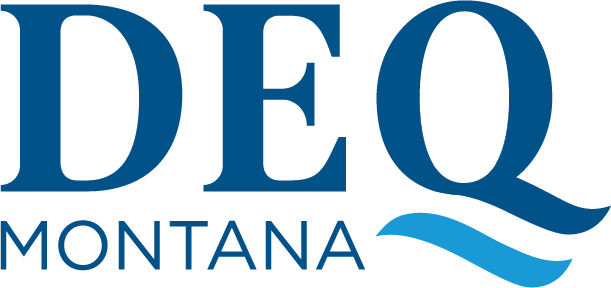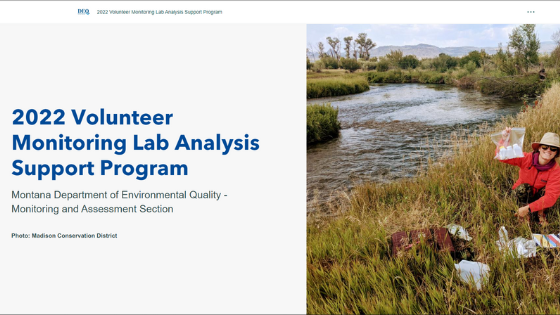Program Overview
DEQ’s Water Quality Monitoring and Assessment Section assesses whether state waters meet water quality standards and support beneficial uses. Beneficial use assessment is one step in the water quality planning process; it requires monitoring and informs Total Maximum Daily Loads (TMDLs) and water quality protection and restoration. Tracking changes in water quality may also be important to determine if conditions are improving or deteriorating over time. DEQ supports numerous professional and volunteer monitoring partnerships across Montana that align with our vision.
DEQ monitors chemical, physical, and biological properties of our state’s rivers, streams, lakes, and wetlands. High quality data is necessary to support decision-making. DEQ monitors water quality to:
- Educate people about water quality;
- Inform watershed restoration and protection plans;
- Track trends in water quality;
- Investigate water quality problems, threats, and improvements;
- Assess whether waters meet water quality standards and support beneficial uses;
- Evaluate sources of pollution;
- Support studies that determine total maximum daily load (TMDL) development;
- Establish baseline conditions;
- Develop water quality standards.
Monitoring & Assessment Contacts
Section Supervisor
Darrin Kron (406) 444-4765
Volunteer Monitoring | Water Quality Scientist
Abbie Ebert (406) 444-5390
Water Quality Scientist
Gabrielle Metzner (406) 444-2709
Water Quality Scientist
Blake Towarnicki (406) 444-2838
Monitoring Scientist
Ella Bushnell (406) 444-7450
Monitoring Scientist
Erin Eberhard (406) 444-5974
Data Assistance
Deanna Tarum (406) 444-2478
Across Montana, trained volunteers monitor water quality in our rivers, streams, lakes, and wetlands. Volunteer monitoring is a fun and effective tool to educate people about protecting water quality and to engage communities in pollution prevention and restoration. Volunteer monitoring programs are administered by watershed groups, conservation districts, water quality protection districts, non-profit organizations, schools, and other entities. DEQ also provides volunteer monitoring opportunities.
Each volunteer monitoring program is driven by a unique set of monitoring objectives. Volunteers may collect chemical, physical, or biological parameters to evaluate water quality, aquatic habitat, and streamflow. Whether they collect high-quality data for decision-making, or monitor solely for educational purposes, DEQ values the contribution of volunteer monitoring programs.
DEQ’s Volunteer Monitoring Support Program supports volunteer monitoring in several ways:
- Financial support, such as our Volunteer Monitoring Lab Analysis Program;
- Technical support, such as trainings and guidance documents;
- Administering volunteer monitoring opportunities; and
- Forming partnerships with other entities in the state that also support volunteer monitoring.
Volunteer Monitoring Lab Analysis Support Program
Each year, DEQ seeks applications for up to $6,000 from volunteer monitoring programs seeking financial assistance with laboratory sample analysis and shipping costs associated with water quality monitoring projects. Applicants are required to submit an application, a Sampling and Analysis Plan (SAP), and an analytical budget which matches their funding request. This program is for laboratory analysis and sample shipping costs only and does not include funding for Sampling and Analysis Plan (SAP) development, travel, monitoring time, purchasing and maintaining field equipment, or other operational costs. All data that is collected using these funds must be uploaded by the awardee to DEQ’s water quality database (MT-eWQX).
- 2025 Application (due by 5:00 p.m. on February 21, 2025)
- VMLASP Informational Webinar
- VMLASP Presentation pdf
- 2025 VMLASP Application Scoring Sheet
- 2025 Monitoring Lab Analysis Parameter Suite and Price List
- Budget Table Template
- Volunteer Monitoring Sampling and Analysis Plan (SAP) Template
- Project ID and Station ID Overview Guidance Document
- Submit Water Quality Data
Volunteer Monitoring Guidance & Resources
Monitoring Planning
- Sampling and Analysis Plan (SAP) template
- Monitoring Methods Selection Guide
- Volunteer Monitoring Planning Catalogue
- Montana Watershed Coordination Council Monitoring Resource Library and Program Search
Equipment
- To inquire about equipment available for loan, contact DEQ’s Water Quality Monitoring and Assessment program (406-444-3507) or MSU Extension Water Quality program (406-994-7381)
Quality Assurance/Quality Control and Data Management
Volunteer Monitoring Support Partners
Beneficial use assessment of Montana's rivers, streams, and lakes is tied to goals of the federal Clean Water Act and the Montana Water Quality Act which require states to:
- Assign designated uses to waters and develop water quality standards to protect those uses;
- Monitor and assess water quality;
- List impaired waters that do not meet standards;
- Identify pollutant sources and set pollutant-reduction goals needed to achieve standards.
DEQ uses available data to assess water quality based on established water quality standards and reports on the status and trends of water quality every two years in Montana’s Water Quality Report and List of Impaired Surface Waters.
What are Beneficial Uses?
Under the Clean Water Act, all surface waters are designated with specific beneficial uses that they should be capable of supporting. Beneficial uses are the various ways a waterbody can be used, including:
- Drinking, culinary and food processing;
- Bathing, swimming and recreation;
- Growth and propagation of salmonid or non-salmonid fishes and associated aquatic life, waterfowl, and furbearers;
- Agricultural water supply;
- Industrial water supply.
What are Water Quality Standards?
Water quality standards specify maximum allowable levels of alteration during use of state waters (Mohr, 2012). Water quality standards are established to protect designated beneficial uses; the standards describe the desired condition of a waterbody and are the benchmarks to aim for in protecting and maintaining water quality.
Water quality standards consist of designated uses, criteria to protect designated uses, and nondegradation requirements to protect existing uses and high-quality waters. Water quality criteria can be numeric (e.g., the maximum pollutant concentration allowed in a waterbody) or narrative (e.g., a criteria that describes the desired conditions of a water body being “free from” certain negative conditions, or “no increases are allowed above naturally occurring concentrations”).
What are Impaired Waters?
DEQ monitors and assesses state waters to identify waterbodies or waterbody segments, also known as assessment units, that are threatened or impaired (MCA 75-5-702). A waterbody is considered “impaired” if it fails to meet one or more water quality standard. Impaired waters do not fully support all their designated beneficial uses. Montana’s Water Quality Integrated Report contains the list of impaired waters. Impaired waters remain on the list until there is sufficient credible data to remove them, and causes of impairment carry over from each biennial reporting cycle until they are removed.
What is the 303(d) List?
Section 303(d) of the Federal Clean Water Act requires each state to develop a list of waters that do not meet water quality standards. The 303(d) list is a subset of Montana’s impaired waters list; waterbodies on the 303(d) list have at least one impairment caused by a pollutant for which a TMDL needs to be developed, and they are not expected to meet water quality standards even after technology-based controls for point sources or other control requirements such as Best Management Practices (BMPs) for nonpoint sources. States are required to submit their 303(d) lists to EPA every other year.
What is a Pollutant?
Pollution is the man-made or human-induced alteration of the chemical, physical, biological, and radiological integrity of water that has a harmful effect on any living thing that drinks or uses or lives in it. Pollution may be from a point source, a single identifiable source from which pollutants are discharged such as a pipe. Pollution may also be from nonpoint sources which are typically diffuse and include all forms of pollution not regulated by a discharge permit under the Montana Pollutant Discharge Elimination System.
Pollutants are a category of pollution. A pollutant is any substance that is introduced into a water resource, naturally or by human activities, that adversely affects the water quality for a specific use. Pollutant causes of impairment include heavy metals, sediment, nitrogen, phosphorus, E. coli, salinity, pesticides, polychlorinated biphenyls (PCBs), and many others. For each waterbody-pollutant combination that appears on the 303(d) list, a Total Maximum Daily Load (TMDL) study must be developed to identify the maximum amount of a pollutant a waterbody can receive and still meet water quality standards. Non-pollutant causes of impairment for which TMDLs are not needed include habitat alterations, flow alterations, etc.
How Do We Assess Beneficial Use Support?
The goal of beneficial use assessment is to use the best available data and science to assess the condition of Montana’s surface waters and support water quality protection and improvement.
Assessment Priorities
DEQ progresses throughout the state to assess waterbodies or waterbody segments that haven’t been already or recently assessed. Often, DEQ assesses multiple waterbodies within a watershed following a watershed approach, and evaluates multiple types of pollution at once. Assessments are often completed in watersheds where Total Maximum Daily Loads (TMDLs) have not already been completed
Assessments identify probable causes and sources of impairment and inform stakeholders interested in implementing activities to protect and improve water quality. Removal of impairments from the list of impaired waters is a common end goal of restoration and assessments can help track or confirm water quality improvements.
Data Collection and Call for Data
DEQ collects chemical, biological and physical parameters for waterbodies conforming to data quality requirements specified in DEQ’s beneficial use assessment methods. Monitoring for beneficial use assessment purposes aims to identify probable causes and sources of pollution. DEQ can only assess water quality and modify the list of impaired waters if there is sufficient credible data.
During beneficial use assessment, DEQ compiles and reviews all currently available data, including that obtained from federal, state, and local agencies, private entities, or individuals with an interest in water quality protection. Every two years, DEQ releases a “call for data” in which people are invited to submit data to DEQ for consideration during assessment.
Assessment Methods
DEQ evaluates data to ensure it meets data quality requirements specified in DEQ’s beneficial use assessment methods. DEQ then uses these same methods to analyze the data and decide whether a waterbody is impaired or not. Assessment methods are dynamic and change as new information and assessment techniques become available. Periodic updates aim to result in more accurate and reliable assessment decisions. Montana’s beneficial use assessment methods include:
- Beneficial Use Assessment (PDF)
- Metals (PDF)
- Sediment in Mountainous Streams (PDF)
- E. coli (PDF)
- EC and SAR in Rosebud Cr, Tongue, Powder and Little Powder R., and Tongue Res. (PDF)
- Sulfate Guidance
- Nitrate Guidance (PDF)
- Ammonia Toxicity (PDF)
- DEQ Monitoring Parameter Suite
- Montana Water Monitoring Program Search
- Monitoring Resource Library
- EPA Environmental Measurements and Modeling
- National Water Quality Monitoring Council
- National Environmental Methods Index (NEMI)
- USGS Water Data for Montana
- Fish, Wildlife & Parks Aquatic Invasive Species
- FishMT
- DNRC and MBMG Surface Water Assessment and Monitoring (SWAMP) Program
- Montana Bureau of Mines & Geology Ground Water Information Center (GWIC)

